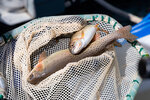Clear, 32° F
State and federal officials are working quickly to remove invasive brook trout from Soda Butte Creek near Yellowstone National Park’s Northeast Gate in an effort to save the largest remaining …
This item is available in full to subscribers.
The Powell Tribune has expanded its online content. To continue reading, you will need to either log in to your subscriber account, or purchase a subscription.
If you are a current print subscriber, you can set up a free web account by clicking here.
If you already have a web account, but need to reset it, you can do so by clicking here.
If you would like to purchase a subscription click here.
Please log in to continue |
|


State and federal officials are working quickly to remove invasive brook trout from Soda Butte Creek near Yellowstone National Park’s Northeast Gate in an effort to save the largest remaining riverine population of Yellowstone cutthroat trout in existence.
The park, in coordination with Montana Fish, Wildlife and Parks and Custer Gallatin National Forest, has resumed the Soda Butte Creek Native Fish Restoration Project this month to remove the newly discovered brookies using an approved piscicide. They have already deployed crews to electro-fish the creek to remove and translocate cutthroats to a safe holding pond prior to the use of the efficient fisheries management chemical rotenone.
The restoration project has been ongoing (as needed) for more than two decades to rid the waterway of the hard to remove species. The last time the species was found in the park was in 2016. The removal efforts were first started in the 80s, according to Todd Koel, who leads the Native Fish Conservation Program for the park.
The species were once restricted to a small tributary in the Blue Creek headwaters above what was then the McLaren Mine tailings above Cooke City, Koel said. Once they started cleaning up the mine tailings in the 1990s, the brook trout were able to escape the upper part of the creek and began to distribute downstream, and eventually ended up in the park.
“[State and federal agencies] worked together annually to electro-fish Upper Soda Butte Creek in the park and in Montana to suppress the population and keep them from expanding their range downstream, because they’re very harmful fish,” Koel said.
Brook trout, which can easily out-compete cutthroat trout for food and space, would cause huge problems for the protected ecosystem if they reach the Lamar River. The park has been doing annual monitoring with electrofishing and environmental DNA analysis.
“It was only last fall that we found a few fish in there,” he said.
While Yellowstone does not stock cutthroat trout inside park boundaries, they did some “supplemental stocking” upstream around Cooke City and Silver Gate after the 2016 treatments.
“The cutthroats rebounded to an abundance that was even greater than prior to the treatments when the brook trout were there. So it was really successful,” Koel said.
Brookies can spawn at smaller lengths and younger ages than cutthroats. They are also fall spawners, which means they emerge from the gravel earlier than the cutthroats, said Montana Fish, Wildlife and Parks Regional Fisheries Manager Shannon Blackburn.
“They start out with a size advantage,” she said. “There are a couple examples where Yellowstone cutthroat trout populations have just been decimated by non-native brook trout.”
The Lamar River watershed is huge, and most of it is extremely remote and isolated. Koel said there are no other brook trout in the entire Lamar watershed, but if they were to get down into the “Lamar River proper” and allowed to expand into the headwaters, over time those populations would cause a lot of damage.
“Brook trout have overtaken a lot of places. So that’s the last thing we want. This is one of the last remaining large river migratory populations of Yellowstone cutthroat trout that exist anywhere,” Koel said, adding, “We’re trying to maintain that large river migratory meta-population that’s going on out there.”
State and federal wildlife agencies classify Yellowstone cutthroat trout as a species of concern. However, the US Fish and Wildlife Service recently concluded the iconic western species does not warrant listing as a threatened species under the Endangered Species Act.
The team is planning to test the captured brook trout otoliths (small oval calcareous bodies in the inner ear of vertebrates) in an effort to find out the species’ origins. Brookies are in surrounding habitats, but Koel said he is not ruling out illegal bucket biologists.
Blackburn said despite the current efforts, they are not trying to rid southern Montana of brookies.
“We’re not removing brook trout everywhere. It’s a very select area where we think that projects can be successful and where the conservation of [Yellowstone cutthroat trout] is really important,” she said.